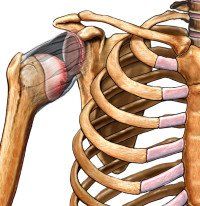Shoulder Dislocation
The most commonly dislocated joint in the body is the shoulder. The shoulder is often a very unstable joint, and the ball + socket design is often compared to a golf ball being supported on a golf tee. In order to provide optimal stability, the shoulder requires a very strong ligament and muscular support system.
Shoulder Dislocations are common and mainly occur as a result of a traumatic injury such as a fall, a car accident, or sports. During the incident, the force on the shoulder is so strong that it actually dislocates the head (ball) of the humerus from its normal resting place within the glenoid cavity (socket). The result is a dysfunctional shoulder that will remain painful unless replaced back to its normal position. In chronic or massive dislocations, excess damage can occur to the supportive ligaments and shoulder structures.
Treatment for dislocations primarily depends on the severity of injury. A brief period of immobilization is typically used by your physician to allow the structures of the shoulder to heal properly. Shoulder therapy is often prescribed to assist in regaining lost motion, increasing strength & stability, and decreasing pain. In more severe cases where dislocation becomes a chronic issue, then several surgical options persists to tighten the structural shoulder musculature to prevent further injury. Shoulder Therapy will typically be prescribed after the surgery to help improve mobility, stability, strength and general function.
MEDICAL DISCLAIMER: The information contained in this website is intended for informational and educational purposes only. You should always with your physician for the diagnosis and treatment of any injury or condition. The content on this web site is general in nature and not complete, and it should never be used for diagnostic or treatment purposes.
